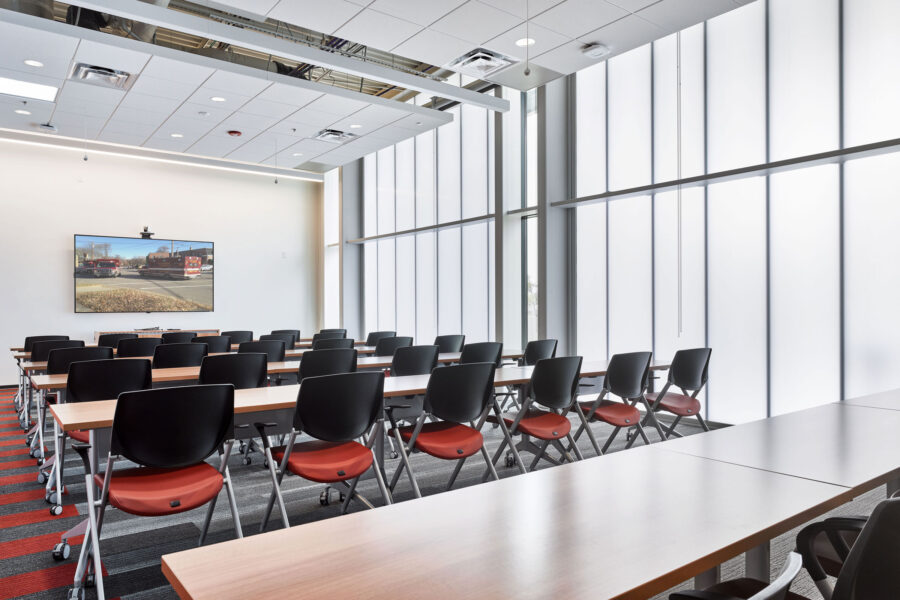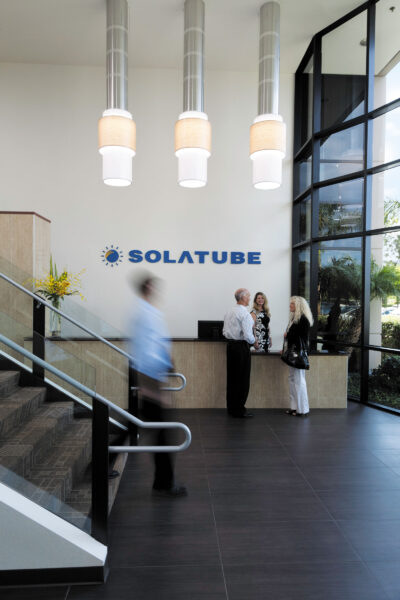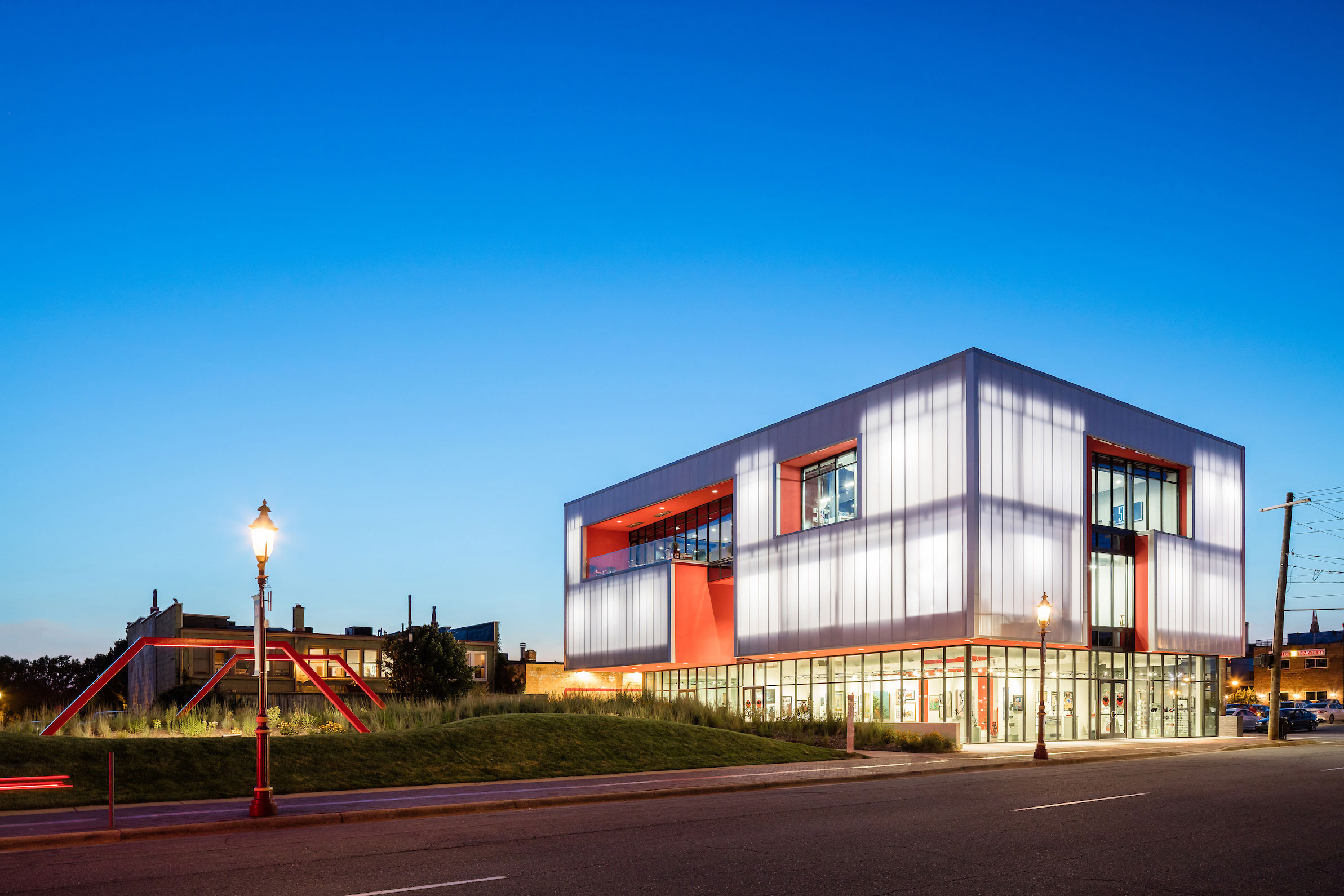Story at a glance:
- Kingspan Light + Air and Solatube International share green initiatives for a brighter future.
- Kingspan Group’s sustainable solutions run the gamut from insulated panels and daylighting products to water preservation, waterproofing, and even data center airflow management systems.
- Innovative daylighting and building envelope solutions can help architects earn up to 20 LEED points for their projects.
Since 1965 Kingspan has been providing innovative insulation and building envelope solutions. Today Kingspan Group, which includes Kingspan Light + Air (KLA) and Solatube (the world’s leading manufacturer and marketer of Tubular Daylighting Devices), has 120 manufacturing sites across 80 countries—and all have all adopted what the company says is one of the most aggressive global sustainability targets in the construction industry.
“We take the stewardship of the environment very seriously,” says Neall Digert, vice president of innovation and market development for Kingspan Light + Air in North America. “It’s not only creating energy-efficient products that help architects create low-carbon, efficient buildings, but it drives how we make our financial decisions every day. It really guides what initiatives we choose and what product development occurs.”
In 2011 Kingspan set a goal to be a net zero energy company by 2020; they delivered on that promise early, in 2019. “At the time that was an almost unheard of goal, but we love a good challenge,” says Brent Trenga, the North America director of sustainability for Kingspan. The team began to brainstorm how they could make even more impact as a business, arriving at 12 measurable targets that are now part of their Planet Passionate program.
What is Planet Passionate?
The 10-year Planet Passionate program aims to decarbonize Kingspan’s entire operational footprint—from the materials they use to their manufacturing process to water consumption and more. Every year every business within Kingspan Group must meet strict KPIs—and every year they do.
“That really is focused on the reduction of energy, carbon, water, and circularity,” Trenga says. “We have very aggressive absolute zero targets that every business unit in every region has to meet.”
Digert says the program is a reflection of how Kingspan operates every day. The proof is in the numbers. In 2022 they recycled 803 million PET bottles into their processes; they’re working to recycle 1 billion into their insulation by 2025. Last year they reduced waste sent to the landfill by 42%, and they’re working toward zero company waste in landfills by 2030.
We have this amazing portfolio of products with anything an architect can think of.
“So many companies are jumping on the greenwashing bandwagon, but when you dig deeply into how a company operates, it doesn’t boil down into the core of the company,” Digert says. “This drives how we make our financial decisions every day. It guides what initiatives we choose, what product development occurs, and it is truly baked into how we operate.”
In 2022 Kingspan achieved a 26% reduction in Scope 1 & 2 GHG emissions, progressing toward their target of net zero carbon manufacturing by 2030. They also increased their direct use of renewable energy from 19.5% to 33.4% relative to the 2020 base year, progressing toward the target of 60% by 2030.
Being environmentally friendly has always been part of the mission. Trenga says Kingspan is nimble and “startup-esque” in its thinking, even though it’s a $10 billion public company. “It’s fundamentally the way we act.”
But it’s not just the decisions Kingspan makes every day in its own processes that make it a sustainable company; it’s the leadership they bring to the industry. “Not only are we constantly experimenting with new opportunities to make products more efficient, more sustainable, reducing the carbon footprint of the entire product and process—we’re also leading the industry in developing new technologies and new formulations of materials,” Digert says.
Existing buildings and construction are responsible for 39% of annual related CO2 emissions globally. Kingspan is working to change that with sustainable solutions that run the gamut from insulated panels and daylighting products to water preservation, waterproofing, and even data center airflow management systems. They are also committed to tackling challenges in areas like raw materials, with continuous supplier engagement, including site visits and early-stage materials testing of all potential new raw material. “We’re leading by example, and our actions trickle into the rest of the construction sector,” Trenga says.
Sustainable Buildings

In 2022 Kingspan harvested 26.1 million liters of rainwater, progressing toward a target of 100 million liters of rainwater annually harvested by 2030. The IKON Global Innovation Center—Kingspan’s headquarters in Ireland, uses nearly every Kingspan product manufactured as a sort of showcase of possibility. Photo courtesy of Kingspan Light + Air
Kingspan’s facilities also generate their own power. “Across the globe every business we own is in the process of installing onsite generation—be it solar, wind, geothermal, or other technology,” Trenga says. “Within that 60% of our energy footprint has to be direct renewable energy. Beyond that 20% of the entire footprint of Kingspan Group needs to be generated onsite.”
Solatube’s own facilities are a great example of the Kingspan family solutions in action, Digert says. “When you walk into the building it is clear the business operates differently than the traditional architectural product company. The first thing you’ll notice is there are no electric lights on. We are fully daylit for 90% of the occupied day throughout the year. Wherever people are working, they are working under the perfect light source all the time.”
That’s both a major reduction in the facility’s energy consumption and in the carbon footprint overall. Solatube has also invested in a 1.3 gigawatt PV system that’s being installed on the campus, combining daylighting strategies with PV to maximize energy efficiency. Solatube daylighting solutions are used at other Kingspan facilities, architectural insulated metal panel systems are used at Solatube, and so on—using each other’s products across facilities.
“We really keep it in-house and share products and share technology,” Trenga says. The IKON Global Innovation Center—Kingspan’s headquarters in Ireland, uses nearly every Kingspan product manufactured as a sort of showcase of possibility. They’ve had an incredible return on investment over the last 18 years. “We want to prove the business case that this can be done at scale—and a very profitable scale at that,” he says. “There is no penalty to operate and do the right thing as a large global entity.”
Kingspan’s core customers are sustainably minded architects and building owners who want to design and build greener buildings. “We have this amazing portfolio of products with anything an architect can think of relative to building envelope or daylighting or even interiors, raised flooring, things of that nature. We have the sustainable solution to draw from,” Digert says.
Earning LEED Points

“When you walk into a daylight space, it is remarkable and how it makes us feel and how it renders architecture is very different from standard lighting,” says Neall Digert, vice president of innovation and market development for Kingspan Light + Air in North America. Photo by Mike Rebholz Photography
In Madison, Wisconsin, a neighborhood fire station uses Kingspan’s UniQuad translucent polycarbonate wall system. Regardless of building size, solutions like these can help projects earn LEED points. This project earned LEED Platinum certification.
UniQuad translucent wall systems feature a unitized panel design that provides light control and high thermal performance. Systems may be customized to meet virtually any performance and aesthetic need—covering sound control, custom colors and graphics, specialty systems for hurricane and blast protection, and more.
“If we’re talking about trying to decarbonize the building, we’re removing steel studs from the wall system, we’re using very efficient aluminum internal structures to support elements, and then the translucent skin becomes the light emitting device as well,” Digert says. “Because it has multiple air cavities it is very energy efficient. We end up with this win-win—visually, from an energy standpoint, and then biologically as well. The Madison Fire Station does an amazing job.”
The Wisconsin project achieved a 70% reduction in energy consumption—30% reduction below even the most stringent energy code. “It’s an incredible solution, and daylight was a part of it,” Digert says. “They also used ground source geothermal heat pump systems, photovoltaics, and all sorts of things to make this building really unique. It’s a beautiful space.”
Daylight Matters

Photo courtesy of Solatube International
Yes, daylight can help projects earn LEED points—three points for quality, robust daylight—but when you are able to turn off the electric lights, you’re also significantly reducing energy use. Kingspan can also help architects earn points with the right insulation, building controls, and overall building envelope. Ultimately you could rack up as many as 20 points.
“We can have additional points for indoor interior lighting control,” Digert says. “For example, if you use a dimmer in a Solatube product to allow occupants to control daylight as they need.” Architects can also earn points for using products with recycled content in the building envelope system, and up to five points can be earned for innovation and design. “It’s not an insignificant number of points when an architect is applying this innovative daylighting solution to the building envelope.”
Then consider the points earned for energy efficiency when using a daylighting system that provides light while also extracting the heat and UV that is so often problematic in interior spaces. “We’re looking at this huge asset in the overall LEED rating of the buildings. We get a lot of buildings where daylighting systems and energy-efficient envelope technologies are playing a significant role in allowing buildings to routinely achieve LEED Gold and Platinum status,” Digert says.
He also points to the use of insulated metal panel systems, whether it’s the roof deck or the wall system, as a way to make buildings more efficient. Kingspan uses materials that minimize the carbon footprint of those systems and also offers translucent building skins. “It’s no longer opaque architecture with punched windows, but we start to apply these beautiful multi-walled, highly energy-efficient, transparent, or translucent systems where the entire wall is providing a very subtle, very diffuse daylight into the space. It allows us to do something rather unique,” Digert says. “When we couple the translucent wall with unique toplighting, whether it’s a Solatube or a skylight or larger monolithic toplighting scenarios, we can have beautifully balanced, luminous environments. Additionally when we integrate a punched view window into the translucent wall system we no longer have contrast issues visually between the view to the outside and the brightness of the interior architecture.”
The result is a calming, daylit space, he says. “It blends beautifully, and it elicits a psychological response—meeting the human need to have a perceived view of the horizon. It calms people, and it keeps us connected and excited about the space. We’re doing so by mixing and matching this wide array of products to create this beautiful, customized solution for a building.”

